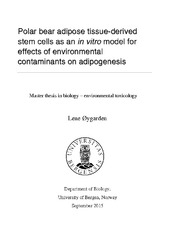Polar bear adipose tissue-derived stem cells as an in vitro model for effects of environmental contaminants on adipogenesis
Abstract
The polar bear (Ursus maritimus) is currently listed as a vulnerable species by the IUCN red list, mainly due to the predicted decline in sea ice caused by global warming. Polar bears are dependent on sea ice for hunting their main prey, the ringed seal (Phoca hispida). Shrinkage of sea ice can result in energetic challenges and increased mortality rates in polar bear populations, as their access to prey declines and the seasonal fasting period gets prolonged. Also affecting polar bears is the exposure and accumulation of persistent organic pollutants (POPs) to unusually high levels due to their lipid rich diet. Some POPs act as endocrine disrupting chemicals (EDCs), leading to metabolic disruption. EDCs may interact with nuclear receptors (NRs), including NRs involved in regulation of metabolism and adipogenesis, e.g. peroxisome proliferator- activated receptor gamma (PPARγ). Interference by environmental contaminants on NRs regulating adipogenesis in polar bear may affect lipid metabolism and thereby decrease their ability to respond to climate change. The aim of this thesis was to develop an in vitro method for studying effects of environmental contaminants on adipogenesis in polar bear by using adipose tissue-derived stem cells derived from polar bear (pbASCs). PbASCs were successfully maintained and propagated in culture and shown to have adipogenic potential when cultivated with adipogenic inducers. Lipid content (Oil red O staining) and transcript levels of the adipocyte specific genes PPARγ, fatty acid-binding protein 4 (FABP4) and leptin (LEP) were used to monitor differentiation of pbASCs. While lipid accumulation and transcript levels of PPARγ and FABP4 reflected the degree of adipogenic differentiation, transcript levels of LEP apparently did not reflect adipogenic differentiation, indicating that LEP may not be a suitable target gene for investigating adipogenic induction in pbASCs. Exposure of pbASCs with known EDCs demonstrated that mono(2-ethylhexyl)phtalate (MEHP) induced adipogenesis, while bisphenol A (BPA) did not. This study has established an in vitro method for investigating effects of environmental contaminants on adipocyte differentiation of pbASCs, by quantification of lipid content and transcript level analysis. The use of pbASCs as an in vitro model for effects of environmental contaminants on adipogenesis can provide valuable information on how contaminant exposure can affect energy homeostasis in the polar bear.
